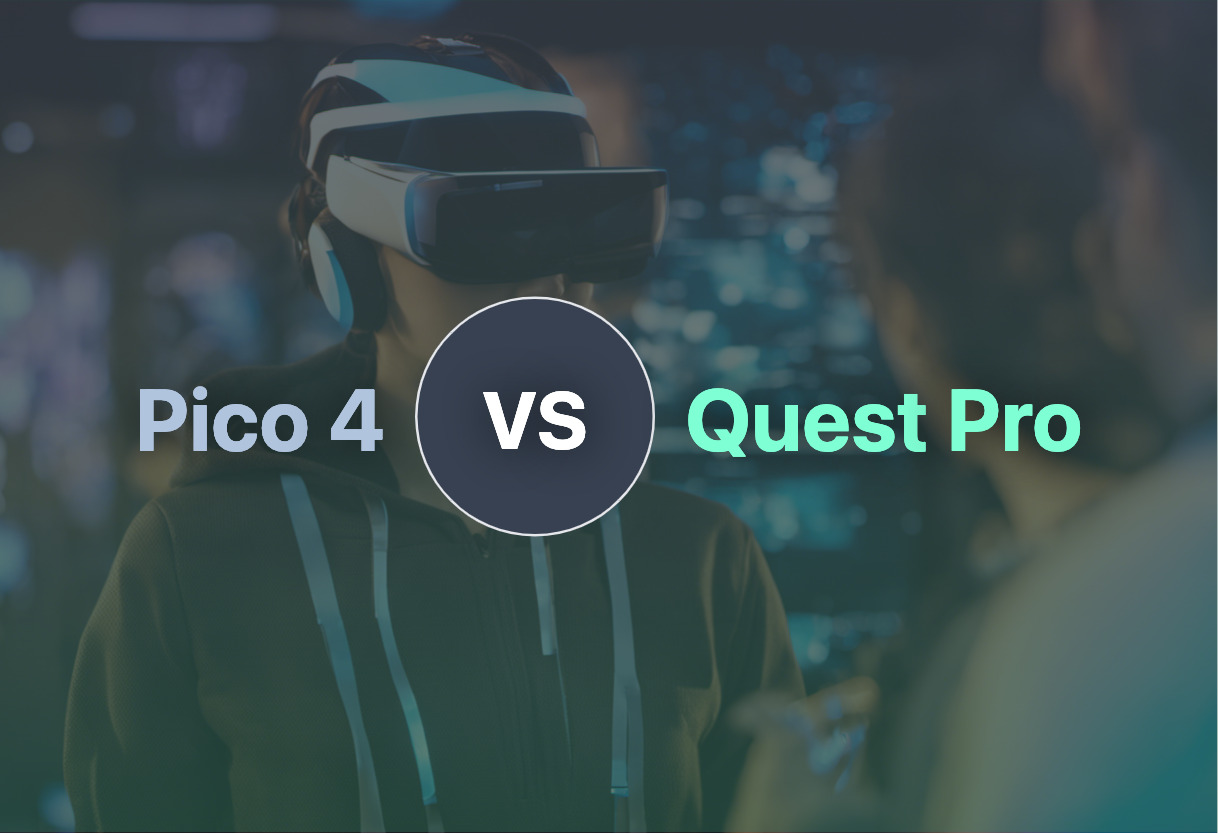Key Differences Between Pico 4 and Quest Pro
- Pico 4 is positioned for a blend of consumer and enterprise use, while Quest Pro predominantly targets enterprise users.
- Quest Pro boasts a Snapdragon XR2+ processor, stronger than Pico 4’s XR2.
- Pico 4 shines in comfort and weight distribution, outpacing the less-comfortable Quest Pro.
- Quest Pro’s higher cost, at $1499.99, may deter some in contrast to Pico 4’s €429 price point.
- With a more vast software suite, Quest Pro offers more for professional workflows.
- Pico 4’s game library is considered limited, potentially restricting intended uses.
- Adjustment features differ: Quest Pro has user-adjustable IPD while Pico 4 offers an automatic function.
In a Pico 4 vs Quest Pro face-off, Pico 4’s ergonomics and price-performance ratio make it an apt choice for VR enthusiasts and smaller enterprises. Quest Pro, with its greater computing power and professional-focused offerings, suits industrial settings with VR-centric operations.

| Comparison | Pico 4 VR Headset | Meta Quest Pro |
|---|---|---|
| Design Philosophy | Emphasizes balance, ergonomics, vivid and immersive experience | Sleek, professional look with focus on workflows integration |
| Key Hardware Features | Qualcomm Snapdragon XR2, 8GB LPDDR4 RAM, Pancake lenses | Snapdragon XR2+, 12GB RAM, 5 cameras, VR/AR capability |
| Positioning System | SLAM omnidirectional | Uses guardian system, full-color pass-through cameras |
| Resolution | Over 2K resolution per eye | 1,920 x 1,800 pixels per eye |
| Sound System | 360° stereo speakers with 3D spatial sound | Has angled speakers |
| Price | €429 | $1499.99 |
| Competitor | Competes with Quest 2 | Costlier than Quest 2, suitable for professional specifications |
What Is Pico 4 VR Headset and Who’s It For?
Launched by ByteDance in 2022, Pico 4 VR Headset garners attention for its balanced design and immersive VR experience in a compact package, a testament to its mission, “small size, big impact”. It’s engineered with a focus on ergonomics, distributing weight evenly across the device for comfort. The headset features a Qualcomm Snapdragon XR2 and 8GB LPDDR4 RAM, supporting a vivid, dynamic VR journey. Its Enterprise variant uses LPDDR5 RAM, specially tailored to business applications, marking this technology as fitting for both personal users and businesses.

Pros of Pico 4 VR Headset
- Ergonomic design for comfort
- Qualcomm Snapdragon XR2 providing high-performance VR experience
- Competitively priced with similar products on the market
- Enterprise variant offering advanced business solutions.
Cons of Pico 4 VR Headset
- Limited game library as pointed out by NookGaming
- Smaller field of view due to the use of Pancake lenses
What Is Meta Quest Pro and Who’s It For?
Focusing on enterprise users and the integration of workflows, the Meta Quest Pro is a powerhouse among VR/AR headsets. Clad in a sleek black design with a glossy front panel, it embodies a professional look and feel. Housing a Snapdragon XR2+ processor and 12GB RAM, this device is built for the heavy-lifting tasks of the professional world. Its high-resolution displays offer an immersive, vivid experience, while its integrated speakers ensure audio quality. Targeting enterprise users with specific VR/AR requirements, the Meta Quest Pro promises optimized professional workflows.

Pros of Meta Quest Pro
- Potent Snapdragon XR2+ processor for high-performance VR/AR experiences
- Sleek and professional design tailored to enterprise users
- High-resolution displays for a remarkable viewing experience
- Motion controllers redesigned for ease of use
Cons of Meta Quest Pro
- The higher cost could limit its reach to professionals only
- Unpadded headset may cause discomfort with prolonged usage
- Limited consumer-focused software leveraging Quest Pro upgrades
Make the Call: Pico 4 or Quest Pro?
The duel of the giants: Pico 4 and Quest Pro. Which to choose largely depends on your specific needs, usage scenarios, and expected outputs.
Enterprise Users
For enterprise users, the Quest Pro holds the throne. Despite a heftier price tag, its advanced Snapdragon XR2+ processor and 12GB RAM offer substantial performance advantages, making it the optimal choice. But prepare to face a limited software library and heftier weight. 
Comfort Seekers
If utmost comfort is your prerogative, your pick should be Pico 4. With its lightweight design and ergonomic features, it offers a streamlined virtual experience while minimizing fatigue. 
Visual Aficionados
Those craving richer visual experiences will find solace in the Pico 4. Boosted by the Pancake lenses and 2K resolution for each eye, the headset provides exceptional visual quality. 
Sound Connoisseurs
For sound connoisseurs, the Pico 4 sings the sweetest symphony. Its 360° stereo speakers equipped with 3D spatial sound take auditory immersion to a new level. 
In the battle between Pico 4 and Quest Pro, the choice comes down to priorities. If professional needs and sheer tech prowess top your list, the Quest Pro wins. But for comfort, visual immersion, and superior sound, consider donning the Pico 4 instead.
Tiffany Brise
Content writer @ Aircada, patiently awaiting a consumer AR headset that doesn’t suck.





